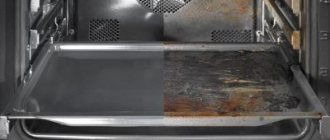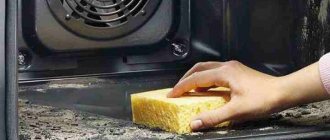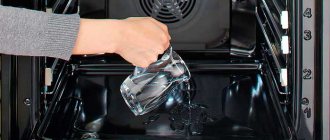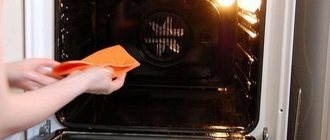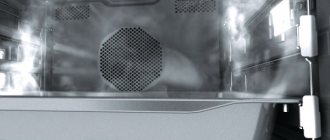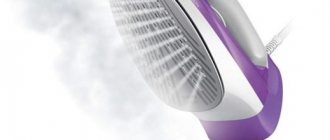It will take you at least two hours to prepare grilled duck with baked potatoes and vegetables for lunch. Not much, but it’s also worth remembering that it also takes time to clean the oven. When you cook food in the oven, fat settles on its walls and bottom. Polymerization of fat molecules and the surface occurs, which forms a thick crust. Getting rid of stuck fat is quite difficult, even with the use of high-quality detergents. If you clean the dirt with your hands, you will waste a lot of time on it. Modern ovens have three possible cleaning options, and when choosing such kitchen appliances, be sure to pay attention to this point. Cleaning in ovens is carried out through pyrolysis, catalysis and hydrolysis. Let's consider all the options in more detail.
Pyrolytic oven cleaning
The term “pyrolysis” in scientific language stands for the thermal separation of organic and inorganic chemical compounds, resulting in the formation of ash and gaseous compounds. This term is made up of two ancient Greek words: Pyr (πῦρ) - fire, heat, bonfire and Lysis (λύσις) - decay, decomposition, stratification. In simple words, the essence of pyrolytic cleaning means the combustion of any contamination that may have formed on the walls of the oven.
The pyrolysis method is so far the most advanced of all existing ones, and an oven equipped with such functionality can safely be classified as a Mercedes among ovens. The fact is that the use of increased temperature automatically means the use of more durable and resistant materials.
Every housewife knows that to prepare the bulk of baked goods, a temperature of 180-250 ° C is required, which means that pyrolysis must be carried out at much higher temperatures, for which standard ovens are simply not designed. Basically, most pyrolytic reactions occur at a temperature of about 500 ° C, although some oven manufacturers have been able to “make” this function work at 300 ° C, but this is not pyrolysis in its pure form, but only part of a multi-level cleaning system.
Since cleaning is carried out at high temperatures, all such ovens are equipped with additional thermal protection for the door and body so that the outside temperature is as low as possible. They are also equipped with a locking mechanism that does not allow the doors to be opened while the temperature inside is above two hundred degrees.
Carrying out the cleaning itself should not cause any difficulties for anyone: all the baking sheets are removed from the oven (in some models this is not necessary - the stands are also made of heat-resistant metal and can be cleaned in this way), the door is closed and the self-cleaning mode is turned on. When the pyrolysis process is completed, you need to wait a while to let the oven cool, after which you can simply sweep away the resulting ash with a brush or rag.
+ Advantages of the pyrolytic cleaning method
- This is in the full sense of the word “self-cleaning of the oven” without human intervention - all that is required is to start pyrolysis and then remove the ashes.
- It is almost impossible to buy a bad oven with a pyrolysis system - only high-quality crucible steel is used for them. Other materials will reveal themselves during the warranty period: the oven will simply “drive” - it will change its shape due to thermal expansion.
- The entire internal surface is cleaned, including the most inaccessible areas - even if the ash does not fall to the bottom from there, it will simply be blown away.
— Disadvantages of the pyrolytic cleaning method
- The use of high-quality materials proportionally increases the cost of the oven.
- Cleaning is carried out separately from food preparation. This means wasted time and additional energy consumption.
- The power of ovens with a pyrolysis system is higher than usual, so in any case you will have to run a separate line for it, designed for at least 6 kW.
- Pyrolysis produces a large amount of gaseous decomposition products, the removal of which requires a good ventilation system.
- Despite high-quality thermal protection, the surface of the oven and the door itself gets quite hot. Although their temperature does not exceed 70-80 °C, this is quite enough to get burned, especially for a child. Therefore, it is advisable that no one is in the kitchen during pyrolysis cleaning of the oven.
User voting
What type of oven would you choose or recommend?
Hotpoint-Ariston 5FA 841 JH IX
20.00 % ( 1 )
Electrolux OEF5E50X
0.00 % ( 0 )
Hansa BOEI64030030
0.00 % ( 0 )
Weissgauff EOV 19 MW
20.00 % ( 1 )
Gorenje BO735E20B-2
0.00 % ( 0 )
Bosch HBJ558YS0Q
60.00 % ( 3 )
Hansa BOEI69422
0.00 % ( 0 )
Electrolux OPEA 4300 X
0.00 % ( 0 )
Korting OKB 792 CFW
0.00 % ( 0 )
Fornelli FEA 45 Sonata
0.00 % ( 0 )
Bosch HBG672BB1F
0.00 % ( 0 )
Electrolux EZC 52430 AX
0.00 % ( 0 )
Electrolux OKD6P71X
0.00 % ( 0 )
Asko OP8676S
0.00 % ( 0 )
Catalytic oven cleaning
When using this method, the effectiveness of the technology used and the cost of its application are combined. It has become widespread because it does not require serious complication in the design of ovens, and at the same time produces a fairly good result.
The whole secret lies in the enamel coating of the oven walls, which contains a catalyst - an active component that decomposes fats into soot and water at temperatures of 150 ° C and above. This means that the cleaning process occurs automatically, right during cooking. It is quite easy to recognize an oven equipped with a catalytic cleaning system by passing your hand inside the heating chamber - on its surface there are panels covered with enamel that is rough to the touch.
Actually, this is the principle of operation of the catalytic cleaning method - when fat is sprayed inside the oven during cooking, it gets onto the panels and lingers on their rough surface. Since the surface of the oven is already heated to the desired temperature, a catalytic reaction begins, which ends during this cooking or will continue during the next one. Some manufacturers build several cleaning modes into ovens - after cooking, you can turn on an additional cleaning mode at a higher temperature.
In terms of efficiency, there is no doubt which type of oven cleaning is better - catalytic is clearly inferior to pyrolysis, but it is cheaper and in any case greatly simplifies the task of keeping the oven clean. In addition, manufacturers are constantly improving the materials they use and the latest catalytic cleaning systems have a much longer service life and require less human intervention when cleaning the oven.
+ Advantages of the catalytic cleaning method
- The cleaning process itself occurs unnoticed - it starts automatically while the oven is operating.
- The cost of ovens with a catalytic cleaning method is within the golden mean and they are quite affordable for a user with an average income.
- Long service life of panels with catalytic enamel - even with intensive use they last for 5 years. In addition, you can find double-sided panels, which, after being worn out on one side, can be turned over and used further.
- Availability of components - when over time you need to replace enamel-coated panels, they are easy to find: in service centers or stores. Here, if necessary, you can order their installation if you do not want to replace them yourself.
- This cleaning method can be used in electric and gas ovens.
— Disadvantages of the catalytic purification method
- Catalytic enamel begins to deteriorate when interacting with sugar or milk. Since during cooking, for example, baking, filling can drip from the baking sheets to the bottom of the oven, panels with a catalyst are attached only to the side and rear walls.
- Panels with catalytic enamel cannot be cleaned with abrasive detergents or hard cloths - they will erase the enamel from the surface.
- Although enamel panels are quite durable, they will still need to be replaced after a while.
- If the surface is heavily soiled, cleaning will have to be repeated several more times.
Pyrolysis, hydrolysis or catalysis – which is better?
Each type of cleaning has its own advantages and disadvantages.
When making a choice in favor of one technology or another, you should consider:
- how often will the device be used,
- what price segment is acceptable,
- what should be the quality of the materials used,
- Is it important to fully automate the process or is minor manual cleaning allowed?
- what is the power of the electrical wiring,
- Do you have a powerful hood at home?
The pyrolysis model is convenient if it is possible to purchase expensive equipment , a wire with a power of at least 600 W is installed, and the kitchen is equipped with a powerful hood.
Hydrolysis does not require large amounts of electricity , eliminating the possibility of burns. The method is quite simple and cost-effective, but requires additional manual work to remove any remaining burnt fat.
If saving money is a priority, then the best option would be a gas stove with a catalytic type of removal of old contaminants, although this type of equipment is less functional than electric ovens. Catalysis is suitable for frequent use of the stove and will greatly facilitate the process of removing old grease and stains.
Hydrolysis oven cleaning
Most likely, this simple but quite effective cleaning method is a folk invention, because every housewife who has had to wash dried dirt from dishes is familiar with it. The essence of the method is the preliminary softening of fats that have reached the walls of the oven, for which water steam is used. To do this, simply take one or two containers of water and place them inside the oven. Then the oven is heated to 50-90 °C and after 30-40 minutes it will be much easier to clean off greasy stains or pies that have dripped onto the bottom of the oven.
In fact, oven manufacturers did not invent a wheel, but simply made a recess in the oven bottom where you can pour water, added a timer for 30-40 minutes and said that such ovens are equipped with a hydrolysis cleaning system. Additionally, for such ovens they began to sell cleaning products that help soften fats and burnt dough under the influence of hot steam.
To the credit of the manufacturers, they did not stop there - the cleaning method itself is unlikely to be improved, but the enamel for oven walls is gradually improving. Its acid resistance increases, and the even and smooth surface has a molecular structure that prevents fat particles from penetrating into it.
+ Advantages of the hydrolysis cleaning method
- Extremely economical - you only need water and a little detergent. Energy costs are minimal since there is no need to heat the oven to high temperatures.
- Safety – no overheating and no danger of getting burned.
- Despite the simplicity and obviousness of this solution, it significantly increases the cleaning efficiency.
— Disadvantages of the hydrolysis method of purification
- You will still have to work hard on complex contaminants.
- You have to set aside separate time for cleaning. In this case, the oven must be cooled down after cooking.
- The method, even by stretch of the imagination, cannot be called automatic - rather, it is simply a simplification of manual cleaning.
FAQ
Is pyrolytic cleaning safe for children?
Make sure that when pyrolytic cleaning the oven door is well locked and the glass and handle do not heat up. If this does not happen, then there is no danger to children.
Is it worth bothering with choosing self-cleaning methods?
Good question. The self-cleaning function is quite expensive, especially pyrolytic. At the same time, you must understand that after the “impact” of this function, a person will still have to work with his hands and spend 15 minutes of time removing grease and dirt. This will be much easier to do than without the help of this function. So, when compared with each other, types of self-cleaning lead to a similar effect and the dirt simply softens, but a person still needs 15-20 minutes to remove this dirt. The difference is up to 5-10 minutes between the most expensive self-cleaning function and the cheapest. If you're not a pedant, then you probably don't need 100% cleaning. In Soviet times, ovens were generally washed once a month or six months. Are you really ready to use this function often and then spend 15-20 minutes of time?
Comparison of oven cleaning systems
| Pyrolytic cleaning | Catalytic purification | Hydrolysis cleaning | |||||||
| Cleaning principle | Any pollution, under the influence of high temperatures, turns into ash | Under the influence of catalysts located in the walls of the oven, fats are broken down | Under the influence of steam, contaminants soften | ||||||
| Electricity consumption | High | Average | Not big | ||||||
| Cleaning temperature | Up to 500 0С | 140 - 250 0С | 50 - 90 0С | ||||||
| Frequency of cleaning application | As needed | After every cooking | After every cooking | ||||||
| Cleaning efficiency | Removes both fresh and old stains | Removes fresh dirt | Helps soften dirt | ||||||
| Requirement for consumables | No | Catalytic panels | Water | ||||||
| Using detergents for final cleaning | No need | Necessary | Necessary | ||||||
| Oven cost | High | Average | Low | ||||||
These are all the main ways to keep ovens clean, the principle of their operation, advantages and disadvantages. But you will have to decide which type of oven cleaning is better in each individual case, depending on the desire to save money when buying an oven, electricity during its operation, or time for cleaning.
If you notice an error, a non-working video or link, please select a piece of text and press Ctrl+Enter .
0
conclusions
We looked at all three oven cleaning systems; which one to choose is up to you. Each of them has its own advantages and disadvantages. The most often asked question is: which oven cleaning is better - steam or catalytic? Here, even experts will not be able to answer you accurately; it all depends on your individual capabilities and needs.
Here's just what you can use as recommendations:
- If you often use the oven and you are not afraid of high energy costs, then you should take a closer look at ovens with pyrolysis.
- If you rarely use your oven, then you should choose a catalytic system.
